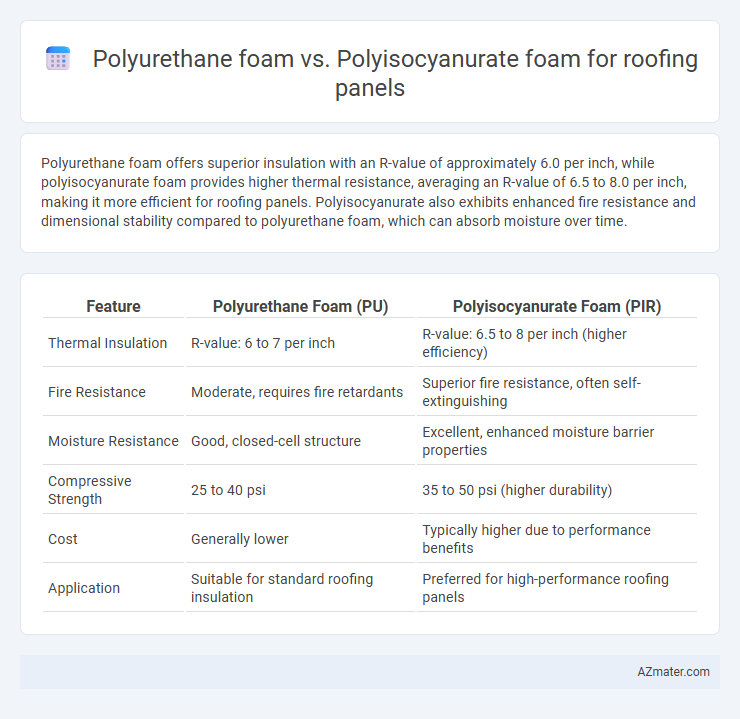Polyurethane foam offers superior insulation with an R-value of approximately 6.0 per inch, while polyisocyanurate foam provides higher thermal resistance, averaging an R-value of 6.5 to 8.0 per inch, making it more efficient for roofing panels. Polyisocyanurate also exhibits enhanced fire resistance and dimensional stability compared to polyurethane foam, which can absorb moisture over time.
Table of Comparison
| Feature | Polyurethane Foam (PU) | Polyisocyanurate Foam (PIR) |
|---|---|---|
| Thermal Insulation | R-value: 6 to 7 per inch | R-value: 6.5 to 8 per inch (higher efficiency) |
| Fire Resistance | Moderate, requires fire retardants | Superior fire resistance, often self-extinguishing |
| Moisture Resistance | Good, closed-cell structure | Excellent, enhanced moisture barrier properties |
| Compressive Strength | 25 to 40 psi | 35 to 50 psi (higher durability) |
| Cost | Generally lower | Typically higher due to performance benefits |
| Application | Suitable for standard roofing insulation | Preferred for high-performance roofing panels |
Introduction to Roofing Insulation Materials
Polyurethane foam and polyisocyanurate foam are popular roofing insulation materials characterized by their high R-values, with polyisocyanurate typically offering R-6 to R-6.5 per inch compared to polyurethane's R-5.5 to R-6 per inch. Polyisocyanurate foam features superior thermal resistance and is more fire-resistant due to its rigid cellular structure and closed-cell composition. Both materials enhance energy efficiency, reduce heat transfer, and provide moisture resistance, making them ideal for commercial and residential roofing applications.
Overview of Polyurethane Foam
Polyurethane foam is a highly effective insulation material extensively used in roofing panels due to its excellent thermal resistance and lightweight properties. It features a closed-cell structure that provides superior moisture resistance and high R-values, typically ranging from R-6 to R-7 per inch. This foam enhances energy efficiency and durability in roofing systems, making it a preferred choice for commercial and residential applications.
Overview of Polyisocyanurate Foam
Polyisocyanurate foam, commonly known as polyiso, offers superior thermal insulation with R-values typically ranging from 6 to 7 per inch, making it more efficient than traditional polyurethane foam. This closed-cell rigid foam features enhanced fire resistance and dimensional stability, ideal for roofing panels in commercial and residential construction. Its reflective foil facers contribute to reduced heat gain, improving overall energy efficiency in building envelopes.
Thermal Performance Comparison
Polyisocyanurate foam exhibits superior thermal performance compared to polyurethane foam, with an R-value typically ranging from 6.0 to 7.0 per inch versus polyurethane's 5.5 to 6.0 per inch. The enhanced closed-cell structure of polyisocyanurate provides better resistance to heat flow, improving insulation efficiency in roofing panels. This higher thermal resistance leads to improved energy savings and greater protection against temperature fluctuations in building envelopes.
Moisture Resistance and Water Absorption
Polyisocyanurate foam offers superior moisture resistance compared to polyurethane foam, with a lower water absorption rate typically below 1%, making it highly effective in preventing water infiltration in roofing panels. Polyurethane foam tends to absorb more moisture over time, which can compromise insulation performance and reduce the lifespan of roofing assemblies. For roofing applications where moisture control and durability are critical, polyisocyanurate foam provides enhanced protection against water damage and maintains thermal efficiency under wet conditions.
Fire Resistance and Safety Considerations
Polyisocyanurate foam offers superior fire resistance compared to polyurethane foam, with a higher ignition point and lower heat release rate, making it a preferred choice for roofing panels in fire-prone areas. The enhanced thermal stability of polyisocyanurate improves safety by reducing the risk of flame spread and toxic smoke emission during fire exposure. Polyurethane foam, although providing excellent insulation, requires additional fire-retardant treatments to meet safety standards, which may impact long-term performance and regulatory compliance.
Compressive Strength and Structural Support
Polyisocyanurate foam offers higher compressive strength compared to polyurethane foam, making it more suitable for roofing panels requiring superior structural support and durability. With compressive strengths typically ranging from 20 to 40 psi, polyisocyanurate provides enhanced resistance to load and deformation under heavy roof traffic or snow loads. Polyurethane foam, while offering good insulation properties, generally has lower compressive strength (around 15 to 25 psi), which may limit its capacity for use in high-stress roofing applications.
Energy Efficiency and Long-Term Savings
Polyisocyanurate foam roofing panels offer superior energy efficiency with R-values typically ranging from 6 to 7 per inch, compared to polyurethane foam's R-values of 5.5 to 6 per inch, making PIR panels more effective at reducing heat transfer and lowering cooling costs. The higher thermal resistance of polyisocyanurate contributes to significant long-term savings by decreasing HVAC energy consumption over the roof's lifespan. Additionally, PIR foam exhibits enhanced dimensional stability and moisture resistance, which reduce maintenance expenses and extend the roofing system's durability.
Environmental Impact and Sustainability
Polyurethane foam and Polyisocyanurate foam differ significantly in environmental impact and sustainability for roofing panels. Polyisocyanurate foam typically offers higher thermal insulation values, reducing energy consumption and carbon emissions over the building lifecycle. Polyurethane foam, while effective, often contains higher global warming potential blowing agents, whereas newer Polyisocyanurate formulations tend to use more environmentally friendly blowing agents and have better recyclability.
Cost Comparison and Value for Roofing Panels
Polyurethane foam generally costs less per board foot than polyisocyanurate foam, offering budget-friendly insulation for roofing panels. Polyisocyanurate foam provides higher R-values--typically around R-6 to R-6.5 per inch--delivering greater thermal efficiency and long-term energy savings despite its higher upfront cost. When evaluating roofing panel insulation, the balance of initial expenditure against superior performance and durability favors polyisocyanurate foam for enhanced value and lifecycle cost-effectiveness.

Infographic: Polyurethane foam vs Polyisocyanurate foam for Roofing panel
 azmater.com
azmater.com